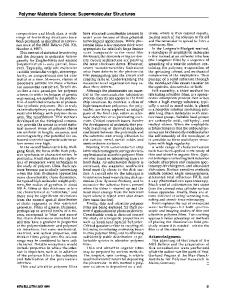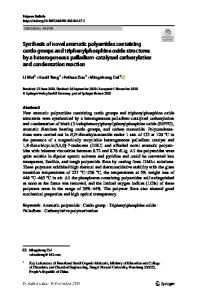Synthesis and Structures of Novel Lanthanide Benzenedicarboxylates
- PDF / 558,062 Bytes
- 6 Pages / 612 x 792 pts (letter) Page_size
- 38 Downloads / 277 Views
1148-PP08-02
Synthesis and Structures of Novel Lanthanide Benzenedicarboxylates Paola Gil-Mateo, Xiqu Wang and Allan J. Jacobson Department of Chemistry, University of Houston, Houston, TX, 77204. ABSTRACT Three novel lanthanum benzenedicarboxylates La2(BDC)3(H2O)4 (1), La4(BDC)3(OH)6 (2) and La3(BDC)2(OH)5 (3) (BDC = 1,4-benzenedicarboxylate) were synthesized by hydrothermal reactions and their structures determined from single crystal X-ray diffraction. All three compounds are 3D framework structures consisting of layers of LaOn polyhedra cross-linked by BDC ligands along the layer stacking direction. In 1 the layers contain separated [LaO6(H2O)2] polyhedra that are bridged by the carboxylate groups of the BDC anions. Compounds 2 and 3 both have highly condensed lanthanum oxide-hydroxide polyhedra. In 2 the layers are wavy and consist of [LaO5(OH)4] and [LaO4(OH)5] polyhedra that share common corners, edges, and faces. In 3, the layers are similar but comprise [LaO3(OH)5] and [LaO4(OH)5] polyhedra. INTRODUCTION Metal organic frameworks (MOFs) are a group of hybrid inorganic-organic framework structures built from isolated metal centers or clusters linked by multifunctional organic ligands forming extended arrays at least in one dimension [1,2]. Design and synthesis of MOFs has captured attention not only because of their structural novelty [3,4] but also for their potential applications in catalysis and gas storage, and because of their optical and magnetic properties [57]. The combination of different coordination numbers of the metal ions and/or their different oxidation states with different organic ligands results in a wide variety of frameworks. Aromatic dicarboxylic acids are excellent organic ligands for the synthesis of MOFs due to their rigidity and chemical robustness. They often lead to frameworks with high thermal stability comparable to inorganic zeolites [8]. The presence of two carboxylic groups affords the formation of a diverse range of conformations and the possibility of different modes of coordination for the carboxylic group, namely mono-dentate, bridging, or chelating [9]. MOFs containing rare earth ions are less common than those containing transition metal ions. The large coordination number, usually from 7 to 10, typically found for rare earth ions and their wide range of coordination geometries makes it difficult to optimize synthesis conditions and to predict the structure of the products [10]. Despite the difficulty in controlling the synthesis, rare earth MOFs are of interest because of their optical and magnetic properties [11,12]. Several rare earth metal organic frameworks have been reported previously, [13-15] with structures containing one-dimensional chains, two-dimensional sheets or three-dimensional frameworks of LnOn polyhedra [16]. In this paper, we focus on the synthesis and structures of compounds containing lanthanum ions connected by BDC ligands. Some previous studies have been carried out using lanthanum as a metal center with different ligands, and the different proper
Data Loading...










